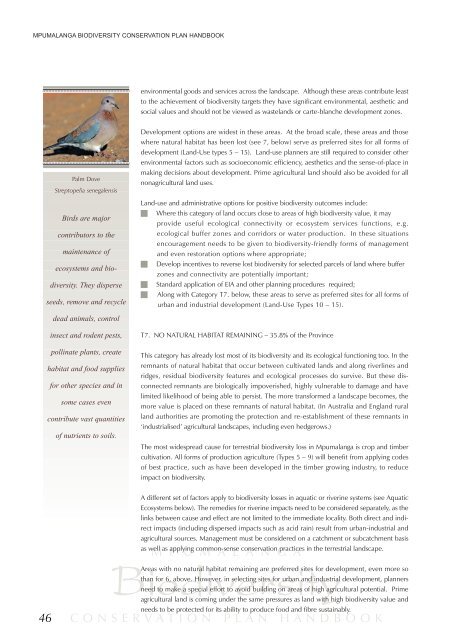Mpumalanga Biodiversity Conservation Plan Handbook - bgis-sanbi
Mpumalanga Biodiversity Conservation Plan Handbook - bgis-sanbi
Mpumalanga Biodiversity Conservation Plan Handbook - bgis-sanbi
You also want an ePaper? Increase the reach of your titles
YUMPU automatically turns print PDFs into web optimized ePapers that Google loves.
MPUMALANGA BIODIVERSITY CONSERVATION PLAN HANDBOOK<br />
46<br />
Palm Dove<br />
Streptopelia senegalensis<br />
Birds are major<br />
contributors to the<br />
maintenance of<br />
ecosystems and bio-<br />
diversity. They disperse<br />
seeds, remove and recycle<br />
dead animals, control<br />
insect and rodent pests,<br />
pollinate plants, create<br />
habitat and food supplies<br />
for other species and in<br />
some cases even<br />
contribute vast quantities<br />
of nutrients to soils.<br />
environmental goods and services across the landscape. Although these areas contribute least<br />
to the achievement of biodiversity targets they have significant environmental, aesthetic and<br />
social values and should not be viewed as wastelands or carte-blanche development zones.<br />
Development options are widest in these areas. At the broad scale, these areas and those<br />
where natural habitat has been lost (see 7, below) serve as preferred sites for all forms of<br />
development (Land-Use types 5 – 15). Land-use planners are still required to consider other<br />
environmental factors such as socioeconomic efficiency, aesthetics and the sense-of-place in<br />
making decisions about development. Prime agricultural land should also be avoided for all<br />
nonagricultural land uses.<br />
Land-use and administrative options for positive biodiversity outcomes include:<br />
Where this category of land occurs close to areas of high biodiversity value, it may<br />
provide useful ecological connectivity or ecosystem services functions, e.g.<br />
ecological buffer zones and corridors or water production. In these situations<br />
encouragement needs to be given to biodiversity-friendly forms of management<br />
and even restoration options where appropriate;<br />
Develop incentives to reverse lost biodiversity for selected parcels of land where buffer<br />
zones and connectivity are potentially important;<br />
Standard application of EIA and other planning procedures required;<br />
Along with Category T7. below, these areas to serve as preferred sites for all forms of<br />
urban and industrial development (Land-Use Types 10 – 15).<br />
T7. NO NATURAL HABITAT REMAINING – 35.8% of the Province<br />
This category has already lost most of its biodiversity and its ecological functioning too. In the<br />
remnants of natural habitat that occur between cultivated lands and along riverlines and<br />
ridges, residual biodiversity features and ecological processes do survive. But these disconnected<br />
remnants are biologically impoverished, highly vulnerable to damage and have<br />
limited likelihood of being able to persist. The more transformed a landscape becomes, the<br />
more value is placed on these remnants of natural habitat. (In Australia and England rural<br />
land authorities are promoting the protection and re-establishment of these remnants in<br />
‘industrialised’ agricultural landscapes, including even hedgerows.)<br />
The most widespread cause for terrestrial biodiversity loss in <strong>Mpumalanga</strong> is crop and timber<br />
cultivation. All forms of production agriculture (Types 5 – 9) will benefit from applying codes<br />
of best practice, such as have been developed in the timber growing industry, to reduce<br />
impact on biodiversity.<br />
A different set of factors apply to biodiversity losses in aquatic or riverine systems (see Aquatic<br />
Ecosystems below). The remedies for riverine impacts need to be considered separately, as the<br />
links between cause and effect are not limited to the immediate locality. Both direct and indirect<br />
impacts (including dispersed impacts such as acid rain) result from urban-industrial and<br />
agricultural sources. Management must be considered on a catchment or subcatchment basis<br />
M P U M A L A N G A<br />
as well as applying common-sense conservation practices in the terrestrial landscape.<br />
<strong>Biodiversity</strong><br />
Areas with no natural habitat remaining are preferred sites for development, even more so<br />
than for 6, above. However, in selecting sites for urban and industrial development, planners<br />
need to make a special effort to avoid building on areas of high agricultural potential. Prime<br />
agricultural land is coming under the same pressures as land with high biodiversity value and<br />
needs to be protected for its ability to produce food and fibre sustainably.<br />
CONSERVATION PLAN HANDBOOK

















